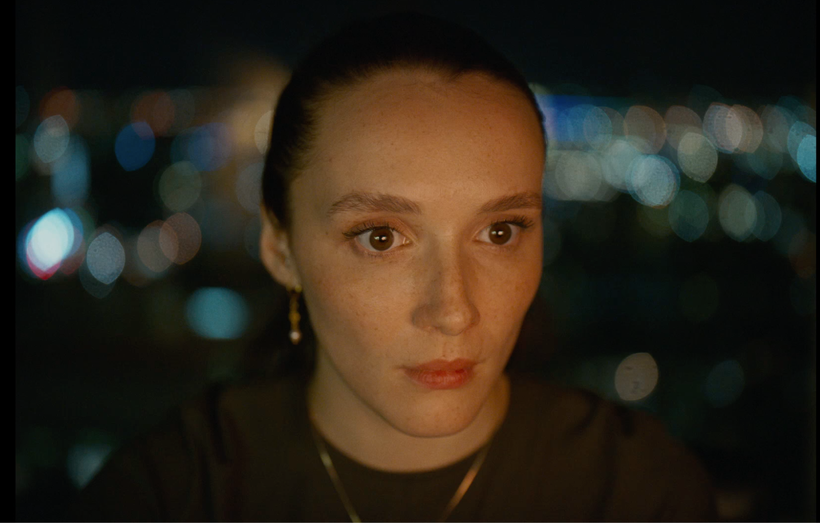Red Rooms (Pascal Plante, 2023) (Patreon)
Content

BY REQUEST: Morris Yang
Pascal Plante's last film, Nadia, Butterfly, had an odd fate. Not only was it "selected" for the nonexistent 2020 Cannes Film Festival. Its entire premise was scuttled by Covid, since it was about a French-Canadian swimmer competing in the equally nonexistent Summer Olympics in Japan. It's hard to say what impact all this had on Plante, but it's worth noting that his new film Red Rooms is so formalist that it practically exists in a germ-free vacuum. That's not to say it has no connection to lived reality, but most of that reality is confined to the darkest recesses of the Internet, where data parcels and screen names interact in the hopes of experiencing something that might penetrate that virtual shell.
The film is about the trial of a serial killer named Ludovic Chevalier (Maxwell McCabe-Locos) whose arrest serves as the first verifiable evidence of the existence of dark-web "red rooms," high-ticket live streams involving rape, torture, murder, and dismemberment. In other words, Ludovic is a purveyor of snuff porn, and Canadian federal police, working with the U.S. FBI, have acquired recordings of two of the murders he's alleged to have committed. So a large part of the premise of Red Rooms asks, what if our most horrific urban legends were suddenly verified? What impact, if any, would this have on a desensitized public?

Our interlocutor is a wealthy model named Kelly-Anne (Juliette Gariépy). Although she is in no obvious way connected to the trial, she camps outside the courthouse each night to make sure she secures a seat in the gallery. She is obsessed with Chevalier, but we never find out exactly why. What we do know is, Kelly-Anne is very online, making most of her living playing high stakes Bitcoin poker. Aside from her modeling gigs, she has no discernible public life, and as we see over the course of the film, she is a fairly adept hacker, using web skills to enter private homes, thwart security cameras, and generally erase her tracks wherever she goes.
Red Rooms is essentially organized around Kelly-Anne's inscrutable, even inhuman reactions to the Chevalier trial and the public impact is has on those around her: the media, the jury and prosecutor, the victims' families, and a young woman named Clementine (Laurie Babin) who is sexually fixated on Ludovic and insists that he is innocent. ("I see it in his eyes.") Kelly-Anne's icy remove suggests that she is not unfamiliar with the world Ludovic inhabits, but Plante wisely avoids letting us know exactly what her role might be.

The first half of the film alternates between the bright white sterility of the Montreal courtroom (where Chevalier is held in a plexiglass pen, like Hannibal Lecter) and the darkness of Kelly-Anne's apartment in a typically Canadian luxury tower. Plante's visual distinction between public and private is absolute, which makes it all the more unnerving when the two realms begin to interpenetrate. In fact, when the Crown Prosecutor (Natalie Tannous) makes her opening remarks, Plante's camera glides laterally around the courtroom in a single unbroken shot. While it is impressive for its own sake, it's not showboating. It provides an impression of legal transparency, as if nothing is going to be withheld. And indeed, the jury are required to watch the two snuff videos in their entirety. (We never see them, but god, do we hear.)
After premiering last year, at Karlovy Vary, Red Rooms went on to open the Fantasia Fest, where it was an immediate sensation, even as viewers did not quite know what to do with it. It's more courtroom procedural than a horror film, and some have written that it's Saint Omer crossed with Demonlover. That's not wrong, but Plante's chilly control of camera, framing, and tone are very Fincher-like, while his thematic preoccupations (mediation, technology, a post-humanist sensibility) are clearly Canadian, echoing both Cronenberg and Egoyan.

Although Red Rooms insists on Kelly-Anne's unknowability until the very end, Plante gives us only one meaningful lead. We don't know why, but Kelly-Anne has seen the stuff films well before the trial, and when she finally shows them to Clementine, the young girl's delusions are immediately dispelled. In other words, as these characters grapple with unspeakable horror, we see that these online experiences have changed them permanently. We don't know if Kelly-Anne was/is a fetishist, an abuse survivor, or just some garden variety 8chan sicko. But Red Rooms holds out its own kind of twisted optimism. The web has not desensitized us quite yet. But this means that there still exist sights and sounds that, like the video in The Ring or Lovecraft's Cthulu, have the power to destroy consciousness. The fact that it hasn't happened yet means that, despite all available evidence, it's still possible to turn back.